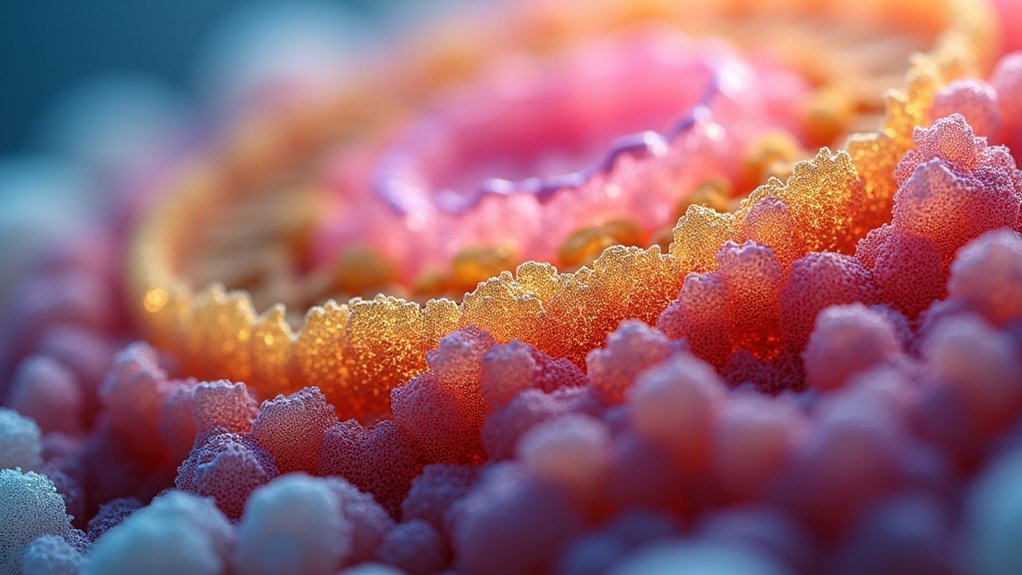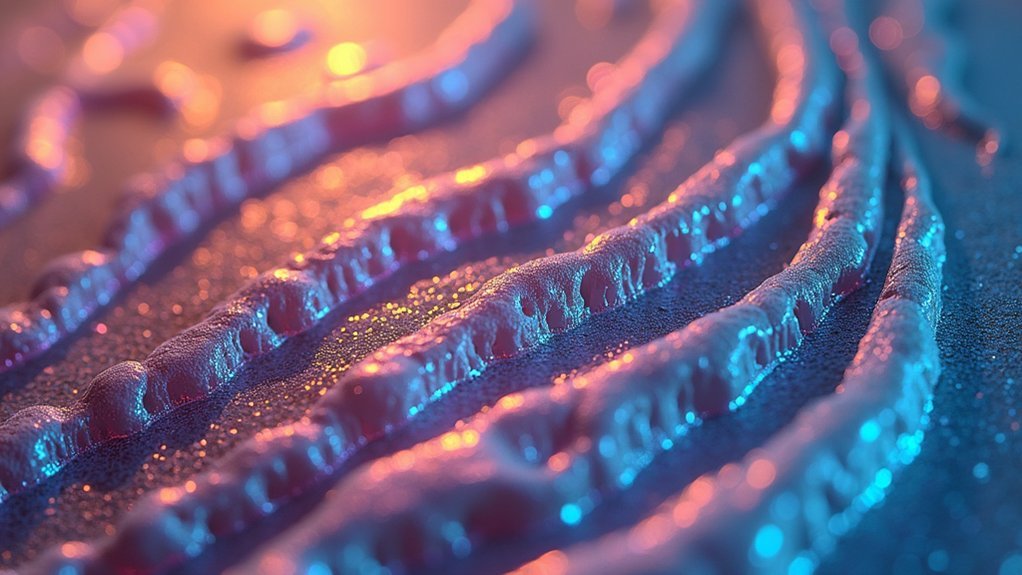Stacking images at 5-micron steps provides ideal overlap within a typical microscope’s 65-micron depth of field, ensuring you don’t miss critical details. These small increments create perfect overlap between consecutive images, preventing focus banding artifacts and maintaining razor-sharp focus throughout your specimen. For objectives like the AmScope 4x (NA 0.1), this step size exceeds the 0.7× DoF guideline, resulting in superior composite images. The science behind these precise movements reveals why serious microscopists insist on such exacting standards.
Second-Level Headings for “Why Stack Images at 5-Micron Steps?”

Five key reasons drive the decision to stack images at 5-micron steps when using the AmScope 4x Plan objective lens.
With this lens having a 65-micron depth of field, 5-micron increments provide ideal overlap between focused areas, ensuring complete subject coverage without missing critical details.
Small 5-micron steps create perfect overlap within the lens’s 65-micron depth of field, ensuring every crucial detail remains razor-sharp.
This precise stepping is essential in macro photography where even minor focusing variations can dramatically impact image quality.
You’ll achieve sharper, more detailed composite images by capturing more focal planes with these small increments.
The 5-micron approach prevents focus banding—those distracting shifts between sharp and blurry areas that can ruin a focus stacking project.
While your specific setup might require adjustments, starting with this increment gives you the precision needed for complex subjects.
Ultimately, these small steps create smoother blending between focused regions, yielding superior final images with exceptional clarity.
The Science Behind 5-Micron Step Precision
The scientific foundation of the 5-micron step approach lies in optical physics and the mathematics of image capture. When you’re working with the AmScope 4x lens, which has a depth of field of approximately 65 microns, utilizing 5-micron steps guarantees complete coverage of every focal plane in your specimen.
Though experts often recommend step sizes of 0.7 times the DoF (around 50 microns), the finer 5-micron steps provide superior precision in macro photography and microscopy settings. This precision helps you avoid focus banding—an artifact that appears when in-focus areas aren’t fully captured between steps in your focus stacked images.
At higher magnifications, where slight focus variations dramatically impact sharpness, this level of precision becomes vital. The 5-micron approach creates a repeatable process that minimizes user error and maximizes consistency.
Calculating Optimal Step Size for Microscope Objectives

Determining the ideal step size for microscope objectives requires understanding mathematical relationships between magnification and depth of field. For objectives like the AmScope 4x Plan with an NA of 0.1, you can calculate the depth of field using the formula: DoF = 0.55μm/(NA²) + E/(M*NA).
The recommended step size is approximately 70% of your depth of field. With the AmScope 4x, this translates to roughly 50 microns (0.7 × 65μm DoF). This guarantees sufficient overlap between consecutive images while minimizing the total number of images needed.
For larger movements, you might use steps of 0.5mm when the camera moves independently from your subject.
Remember that your specific setup may require experimentation—maintain a consistent process to reduce errors and achieve the highest quality stacked images.
Depth of Field Considerations at High Magnification
When working with high-magnification microscopy, you’ll encounter physical limitations where the Z-axis resolution approaches 5-10 microns due to high-NA lens physics.
You’re better off preparing thin sections of your specimen that match your depth of field (roughly 65 microns with a 4x objective) rather than attempting extremely fine 5-micron steps in your stacking process.
Your microscope’s numerical aperture creates a fundamental trade-off between resolution and depth of field, forcing you to balance these factors when capturing detail in three-dimensional specimens.
Z-Axis Resolution Limits
As magnification increases in microscopy, depth of field dramatically shrinks to mere microns, creating significant challenges for capturing fully sharp images.
You’ll find that resolution limits in the z-axis determine how finely you need to step through your sample.
With high-NA objectives like the AmScope 4x Plan, your depth of field may be as shallow as 65 microns.
This physical limitation means you can’t capture your entire subject sharply in a single frame.
By implementing 5-micron steps during focus stacking, you’re working below the resolution limit of the optical system, ensuring complete coverage without gaps.
This approach prevents focus banding artifacts that appear when steps are too large.
The 5-micron increment has proven ideal—small enough to capture all detail while avoiding redundant frames that waste processing resources.
Working With Thin Sections
The challenge of shallow depth of field becomes even more pronounced when examining thin sections under high magnification. When you’re studying these delicate specimens, every micron matters. The calculated depth of field for high-power objectives typically measures just a few microns, making a 5-micron step size ideal for capturing each distinct focal plane without missing critical details.
You’ll find that this precise increment guarantees complete coverage of your specimen while preventing focus banding artifacts. Using larger steps risks creating gaps in your focal data, potentially losing valuable structural information. Conversely, smaller steps generate unnecessary redundancy without improving image quality.
The 5-micron step size strikes the perfect balance—providing enough overlap to seamlessly blend each image while maximizing efficiency in your workflow, especially when dealing with the intricate anatomical features present in biological or geological thin sections.
High-NA Lens Physics
Understanding numerical aperture (NA) becomes critical once you’ve entered the domain of high-magnification imaging. As you increase magnification with high-NA lenses, your depth of field dramatically narrows—sometimes to mere microns.
For instance, an AmScope 4x Plan objective yields only 65 microns of focus depth. This shallow depth of field requires precise step sizes when stacking:
- Higher numerical aperture captures more detail but shrinks your focus zone
- At high magnification, even 50-micron steps can miss critical focus points
- Using 5-micron increments guarantees you’ll capture every subtle focus variation across your subject
The physics behind this relationship is unavoidable—as NA increases, depth of field decreases proportionally.
You’ll need more frequent focus adjustments to overcome this limitation and produce completely sharp composite images.
Relationship Between NA Values and Step Increments
When selecting appropriate step increments for focus stacking, numerical aperture (NA) values play an essential role in determining ideal settings.
With the AmScope 4x lens (NA of 0.1), you’ll find a depth of field around 65 microns, suggesting step sizes of approximately 50 microns would be sufficient.
However, utilizing 5-micron steps in your image stacking process provides significant advantages. This smaller increment exceeds the recommended 0.7x DoF guideline, ensuring complete subject coverage without banding artifacts. You’ll capture every vital detail as you move through the focal range.
Higher NA lenses produce shallower depth of field, requiring these finer step increments. For microscopy applications, where minute focus changes dramatically affect image quality, this precision becomes even more important.
Properly calibrated step increments relative to your lens’s NA value will consistently yield superior stacked results.
Avoiding Focus Banding With Appropriate Step Sizes

Focus banding occurs when you’re using step sizes that are too large, creating visible shifts in your final image stack.
You’ll need to use approximately 0.7 times the calculated depth of field for best results, which translates to about 50 microns for an AmScope 4x Plan objective, though smaller 5-micron steps can provide even smoother shifts.
Your mathematical approach to overlap guarantees you’ll maintain best resolution while creating seamless composite images free from distracting banding artifacts.
5-Micron Overlap Mathematics
To achieve seamless focus stacking results, the mathematics of overlap between consecutive images becomes critically important.
You’ll need to calculate the proper step size based on your lens’s depth of field to prevent focus banding in your stacked images. For best results, aim for step sizes approximately 0.7 times the calculated DoF.
When using focus stacking with the AmScope 4x Plan objective:
- Calculate your lens’s DoF (approximately 65 microns for the AmScope 4x)
- Determine best overlap (50 microns recommended for this lens)
- Choose smaller steps (5 microns) for more precise focus coverage and enhanced detail
Optimal Resolution Maintenance
Maintaining ideal resolution throughout your stacked images depends critically on selecting the appropriate step size between consecutive captures. When you use 5-micron steps during focus stacking, you’re ensuring that each in-focus region overlaps adequately with the next, preventing focus banding artifacts that occur with larger increments.
| Step Size | Resolution Quality | Banding Risk |
|---|---|---|
| 5 microns | Excellent | Minimal |
| 10 microns | Very Good | Low |
| 25 microns | Good | Moderate |
| 50 microns | Fair | High |
| >50 microns | Poor | Severe |
This precise 5-micron increment creates a greater depth of field in your final composite while preserving fine details. Since the ideal step size should be about 0.7× the lens’s depth of field, using consistent 5-micron steps with the AmScope 4x lens achieves smoother shifts between focus planes.
Equipment Requirements for Micron-Level Precision
When attempting micron-level precision in image stacking, your hardware setup becomes critically important. You’ll need specialized equipment capable of consistently moving at 5-micron intervals to achieve ideal focus stacking results. The focal length of your lens system must be matched with appropriate movement capabilities.
For reliable micron-level precision, consider these essentials:
- A stable vertical setup using precision linear rails like the modified THK KR20, eliminating vibration that would compromise image quality.
- A 400-step motor with 1mm thread pitch, enabling movements as precise as 2.5 microns per step.
- High-quality objectives with known numerical aperture, such as the AmScope 4x Plan (NA 0.1), to properly calculate depth of field.
Automated focus rails will greatly improve your repeatability, while extension tubes and bellows can help maintain subject position during the stacking process.
Comparing Results: 5-Micron vs. Larger Step Intervals

When you compare images stacked at 5-micron intervals against those with larger steps, you’ll immediately notice sharper details and fewer focus banding artifacts in the finer-step results.
This quality difference becomes more pronounced at higher magnifications, where the calculated depth of field narrows and demands more precise focus increments to capture all critical elements.
While larger steps might save processing time, they consistently sacrifice resolution and introduce distracting artifacts that compromise the smooth shifts essential for professional-quality macro photography and microscopy work.
Visual Quality Analysis
Although both small and large step intervals produce usable stacked images, the visual quality differences between 5-micron steps and larger intervals become immediately apparent upon close inspection.
When you examine focus stacks created at 5-micron increments, you’ll notice markedly improved visual quality compared to those using 15 or 20-micron steps.
Consider these distinct quality improvements:
- Enhanced microdetail preservation – fine textures remain crisp rather than being averaged out during stacking
- Elimination of focus banding artifacts – those subtle “stripes” of alternating sharpness disappear when using smaller steps
- More natural shifts between focal planes – subjects appear genuinely three-dimensional rather than artificially layered
This precision stacking approach guarantees your macro subjects exhibit their true structure without the distracting artifacts that commonly plague larger-step composites.
Resolution vs. Artifact Trade-offs
Despite the increased shooting time required, the resolution advantages of 5-micron steps greatly outweigh the practical benefits of larger intervals in focus stacking.
When you compare results directly, you’ll notice markedly fewer artifacts in final composites created with 5-micron increments.
Larger step sizes (10-20 microns) often produce visible focus banding where sharp-to-blurry shifts become noticeable in your final image.
With 5-micron steps, you’re capturing multiple images within each 65-micron depth of field segment, creating smoother blends between focused areas.
The enhanced detail preservation is particularly evident in complex subjects where minute textures matter.
While this approach generates more files to process, the resulting image quality—with fewer halos, better edge definition, and more natural focus shifts—justifies the additional capture time and processing requirements.
Magnification Impact Assessment
Magnification levels dramatically influence the effectiveness of 5-micron stacking intervals compared to larger steps.
When you’re working with the AmScope 4x objective lens, which provides roughly 65 microns of depth of field, the 5-micron intervals guarantee you’re capturing all critical depths without missing essential detail.
Compare the results yourself at different magnifications:
- At 4x magnification – Larger steps create noticeable focus banding, while 5-micron steps produce seamlessly blended composite images.
- At higher magnifications – The difference becomes even more pronounced as depth of field narrows dramatically.
- At any magnification – 5-micron stacking images consistently deliver smoother shifts between in-focus areas.
The recommended 0.7x depth of field step size confirms that finer adjustments enhance detail resolution, particularly when working with specimens containing subtle textural variations.
Practical Workflow for Microscope Focus Stacking

When creating high-resolution composite images at the microscopic level, establishing a systematic workflow becomes essential for consistent results.
Start by securing your microscope on a vertical stand with a linear rail that can achieve precise 5-micron movements without vibration.
Set up even lighting with diffusers to eliminate shadows and variations between frames. With the AmScope 4x Plan objective, you’ll find 5-micron steps work well within the 65-micron depth of field, though you might adjust to 50-micron increments for efficiency.
Capture your stack methodically, maintaining consistent conditions throughout.
For post-processing, software like Helicon Focus will align your images and select the sharpest pixels from each frame, creating a seamless composite that reveals details impossible to capture in a single shot.
Resolving Fine Structural Details With Precise Stacking
Through careful application of 5-micron step increments, you’ll access unprecedented clarity in microscopic imaging that reveals structural nuances invisible to conventional photography.
When stacking images at this precise interval—approximately 0.7 times the depth of field for lenses like the AmScope 4x—you’re capturing thorough focus information without gaps.
This precise approach yields three significant advantages:
- Elimination of focus banding – Adjacent images overlap sufficiently, creating seamless shifts between focal planes
- Enhanced three-dimensional representation – Complex structures maintain their spatial relationships when precisely aligned
- Preservation of minute details – Features as small as 5 microns remain crisp and defined throughout the composite
You’ll find this technique particularly valuable when examining intricate morphological features where even the smallest details impact your understanding of the specimen’s structure and function.
Frequently Asked Questions
What Is the Purpose of Photo Stacking?
You use photo stacking to combine multiple images taken at different focus points, creating a single image with enhanced depth of field where all elements appear sharp and in focus.
Why Stack Astro Images?
You’d stack astro images to improve signal-to-noise ratio, reveal faint celestial details, reduce atmospheric interference, and minimize camera noise. This technique combines multiple exposures, allowing you to capture what single shots can’t show.
How Do Image Stacks Improve Image Quality?
Image stacks improve quality by combining the sharpest parts of multiple exposures. You’ll see reduced noise, increased detail, better dynamic range, and elimination of focus limitations in your final composite image.
What Does It Mean to Stack Images on Mobile?
Stacking images on mobile means you’re taking multiple photos at different focus points, then your device merges them into one sharper image with better depth of field, enhancing details that might otherwise be blurry.
In Summary
You’ll find 5-micron steps provide the ideal balance between efficiency and detail for most microscopy applications. By matching your step size to your objective’s NA and depth of field, you’ll capture all structural information without redundant frames. Remember to adjust based on your specific magnification—higher powers may require even smaller increments. For consistent results, invest in a motorized focus system that handles these precise movements reliably.





Leave a Reply